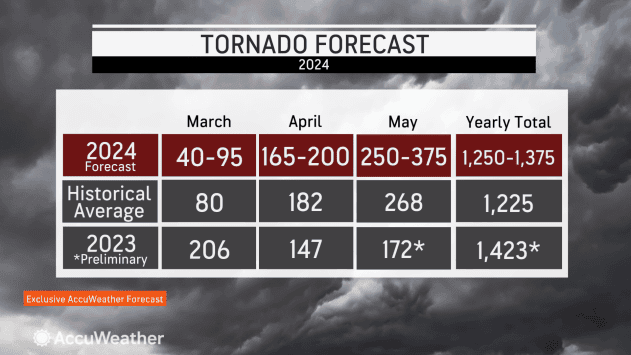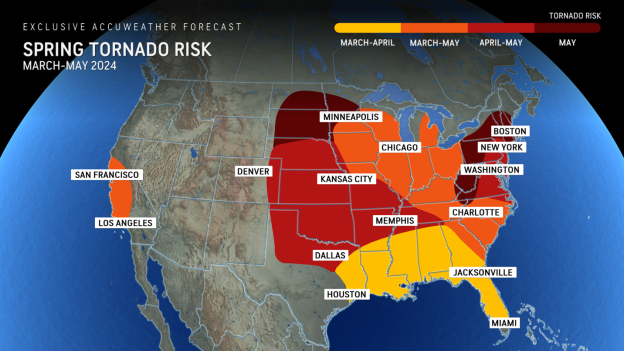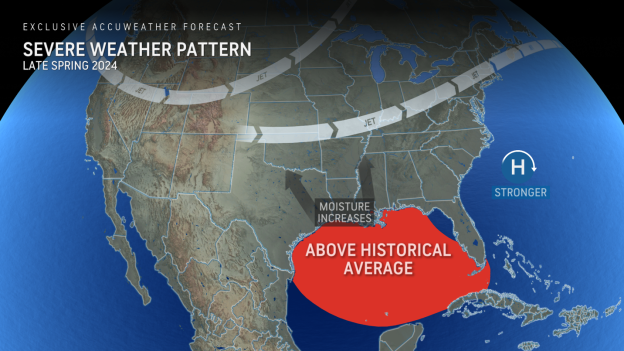Spring brings threat of tornadoes, severe thunderstorms. What you should know in Florida
Meteorological spring arrived March 1, and with it comes new weather threats, this time from tornadoes.
AccuWeather is warning residents across the United States "the threat of damaging thunderstorms and tornadoes across the United States will rise in the coming weeks as the spring severe weather season ramps up."
While the season may get off to a slow start, don't expect conditions to stay that way.
The threat for tornadoes and damaging storms will escalate after reaching the midpoint of the season, according to AccuWeather Lead Long-Range Forecaster Paul Pastelok.
What's that mean for Florida? The highest risk for tornadoes is expected to be in March.
That's sure to be unwelcome news for those in the state already affected by tornadoes earlier this year, including a powerful EF-3 tornado that hit Bay County in January.
AccuWeather predicting above-average number of tornadoes in 2024

AccuWeather's long-range forecasters are predicting 1,250 to 1,375 tornadoes across the U.S. in 2024.
Historically, the average number of tornadoes is 1,225.
If there's any good news to the forecast it's that the prediction is less than the 1,4523 reported across the U.S. in 2023, according to AccuWeather.
Spring tornado risk in Florida highest in March
AccuWeather said it expects the spring tornado threat in Florida to be the highest in March, before trending down in April and May.
"Tornadic activity in March could be near to above the historical average thanks to the influence of an active storm track across the southern states. As the spring progresses, we expect El Niño to weaken, which can allow for the storm track to focus farther north. This can lead to near to below average tornadic activity in April to May" in Florida, AccuWeather said in an email.
What is the average number of tornadoes in Florida by month?
According to the Storm Prediction Center, the average number of tornadoes in Florida are the highest in September. The average number by month are:
January: 3
February: 4
March: 6
April: 4
May: 3
June: 7
July: 5
August: 5
September: 8
October: 3
November: 2
December: 2
Spring will bring severe weather to Tornado Alley

Tornado Alley, which runs from Texas through Nebraska, will continue to live up to its reputation.
Others outside Tornado Alley won't be immune from threat of tornadoes.
Even California also could see more tornadoes in 2024, according to AccuWeather.
"The majority of tornadoes last year touched down outside of the traditional tornado alley, especially in March and April, when most severe weather impacted areas from the Midwest through the Tennessee Valley."A whopping 206 tornadoes were reported across the U.S. in March 2023, well more than double the monthly historical average of 80."
'Don't let your guard down' when it comes to tornadoes
AccuWeather meteorologists warned families and businesses outside of the traditional Tornado Alley to not let their guard down this year.
“The second half of spring is jumping out to us,” said Pastelok. “The severe weather threat can be more frequent in the Midwest, Tennessee and Ohio valleys in later March into May, while the northern Plains and Northeast can have an increase in May.”
“We’ve seen with climate change that severe weather threats, including tornadoes, are happening outside of the time of year and places that people typically associate with tornadoes,” said AccuWeather Chief Meteorologist Jon Porter.
“Do not be lulled into any false sense of security. There can be a tornado threat anywhere in the country with the right conditions.”
Why is more severe weather expected in 2024?

AccuWeather long-range forecasters said the Great Lakes, the Gulf of Mexico, and the return of La Niña will be major factors that set 2024's severe weather season apart from 2023.
“Quick warming of the Great Lakes, combined with below average snowpack in the Midwest, could lead to an early start to severe weather season in this region,” said Pastelok.
El Niño is expected to weaken throughout the spring, which could allow for an uptick in activity in Tornado Alley from April through May.
Water temperatures in the Gulf of Mexico are currently near to slightly above historical averages. If temperatures increase rapidly during the middle and later part of the spring, May could be a critical month for tornado activity.
EF-3 and EF-2 tornadoes hit Florida in January
The National Weather Service confirmed several tornadoes hit Florida Jan. 9. The storms destroyed homes, blew over RVs, blasted walls and roofs off buildings, downed trees and caused multiple power outages.
The most powerful was an EF-3 tornado that left behind destruction in Lower Grand Lagoon.
A second tornado spawned from the same parent supercell thunderstorm as the EF-3 that hit Lower Grand Lagoon also touched down in the Lynn Haven area and tracked northeast, according to the National Weather Service. It was rated as an EF-2. The tornado left behind "significant damage" in the Deer Point Lake area.
Another EF-2 tornado hit Jackson County with estimated peak winds of 125 mph.
More tornadoes hit several other areas in Florida on the same day, including Duval and Santa Rosa counties, and Oldsmar.
Tips to stay safe during a tornado
If driving, do not take shelter under an overpass, and do not try to outrun a tornado. If no shelter is near — like a ditch or sturdy building — stay in your car, make sure your seat belt is on and put your head below the window.
In your home, go to your safe room or the center of an interior room on the lowest level.
If you live in a mobile home, leave immediately for a secure shelter. If none is close by, see options under No. 1.
This article originally appeared on Treasure Coast Newspapers: Florida spring tornadoes. AccuWeather warning threat above-average
